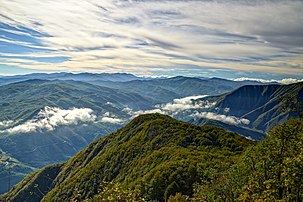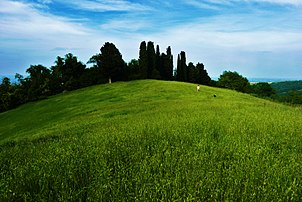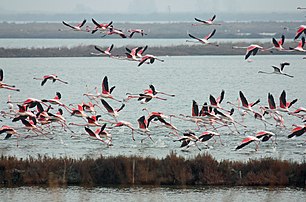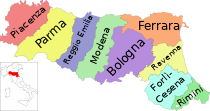Emilia-Romagna
This article's factual accuracy may be compromised due to out-of-date information. (April 2023) |
Emilia-Romagna
Emégglia-Rumâgna / Emîlia-Rumâgna ( Romagnol) | ||
|---|---|---|
|
ISO 3166 code IT-45 | | |
| NUTS Region | ITH[2] | |
| HDI (2022) | 0.940[3] very high · 1st of 21 | |
| Website | www | |
Emilia-Romagna (
Emilia-Romagna is one of the wealthiest and most developed regions in Europe, with the third highest
Etymology
The name Emilia-Romagna is a legacy of Ancient Rome. Emilia derives from the via Aemilia, the Roman road connecting Piacenza to Rimini, completed in 187 BC, and named after the consul Marcus Aemilius Lepidus.[14] Romagna derives from Romània, the name of the Eastern Roman Empire applied to Ravenna by the Lombards when the western Empire had ceased to exist and Ravenna was an outpost of the east (540–751).[citation needed]
History
This section needs additional citations for verification. (August 2023) |

Prehistory and antiquity
Before the Romans took control of present-day Emilia-Romagna, it had been part of the
Early origins
The history of Emilia-Romagna dates back to Roman times when the region of Emilia was ruled by imperial judges linked to the nearby regions of either Liguria or Tuscany. After the fall of the Western Roman Empire in the 5th century, the Lombards, a Germanic tribe, founded the kingdom of Lombardy in northern and central Italy. This kingdom, which included the region known as Emilia, flourished until the Lombard dynasty was overthrown by the Frankish king Charlemagne in 774. From the 6th to 8th centuries, the region of Romagna was under Byzantine rule and Ravenna was the capital of the Exarchate of Italy within the Eastern Roman Empire. In the 8th century, this region became a province of the Papal States when Pepin, the father of Charlemagne, donated the land to the Pope in 754.
Renaissance to early modern period
During the 10th century, northern Italy became part of the Holy Roman Empire under the control of the Germanic leader Otto I. The Holy Roman emperors had varying degrees of control over northern Italy until the close of the Middle Ages. In the 12th century, the papacy extended its political influence and city states began to form in opposition to the Holy Roman emperors.
The northern cities, supported by the Pope, formed the Lombard League and reduced the influence of the ruling Hohenstaufen dynasty over their lands. Division between imperial partisans and their opponents created factions called the Guelphs and the Ghibelines which would divide the cities for centuries. For the next few centuries both Emilia and Romagna were ruled by papal legates or representatives of the Pope.
The
The House of Este gained a notable profile for its political and military might and its patronage of the arts: it left behind a vast heritage of splendid Renaissance palaces, precious paintings and literary masterpieces, such as the works of Ludovico Ariosto, Torquato Tasso and Matteo Maria Boiardo.
Following the rise of
Late modern and contemporary
In the 16th century, most of what would become Emilia-Romagna had been seized by the Papal States, but the territories of Parma, Piacenza, and Modena remained independent until Emilia-Romagna became part of the Italian kingdom between 1859 and 1861.
After the First world war, Emilia-Romagna was at the centre of the so-called Biennio Rosso, a period of left-wing agitations that paved the way for Benito Mussolini's coup d'état in 1922 and the birth of the Fascist regime in Italy. Mussolini, a native of Emilia-Romagna, sponsored the rise of many hierarchs coming from his same region, such as Italo Balbo, Dino Grandi and Edmondo Rossoni.
Towards the end of the
During the
After the referendum of 2006, seven municipalities of Montefeltro were detached from the Province of Pesaro and Urbino (Marche) to join that of Rimini on 15 August 2009.[16][17] The municipalities are Casteldelci, Maiolo, Novafeltria, Pennabilli, San Leo, Sant'Agata Feltria and Talamello.
On 20 and 29 May 2012 two
Geography
This section needs additional citations for verification. (August 2023) |


The region of Emilia-Romagna consists of nine provinces and covers an area of 22,446 km2 (8,666 sq mi), ranking sixth in Italy. Nearly half of the region (48%) consists of plains while 27% is hilly and 25% mountainous. The region's section of the
The plain was formed by the gradual retreat of the sea from the
The
The region has temperate broadleaved and mixed forests and the vegetation may be divided into belts: the
Land use
Emilia-Romagna has been a highly populated area since ancient times. Inhabitants over the centuries have radically altered the landscape, building cities, reclaiming wetlands, and establishing large agricultural areas. All these transformations in past centuries changed the aspect of the region, converting large natural areas to cultivation, up until the 1960s. The trend then changed, and agricultural lands began giving way to residential and industrial areas. The increase of urban-industrial areas continued at very high rates until the end of the 2010s. In the same period, hilly and mountainous areas saw an increase in the registration of semi-natural areas, because of the abandonment of agricultural lands.
Land use changes can have strong effects on ecological functions. Human interactions such as agriculture, forestation and deforestation affect soil function, e.g. food and other biomass production, storing, filtering and transformation, habitat and gene pool.[19]
In the Emilia-Romagna plain, which represents half of the region and where three quarters of the population of the region live, the agricultural land area has been reduced by 157 km2 while urban and industrial areas have increased to over 130 km2 between 2003 and 2008. The impact of
In 2000 there were 103,700 farm holdings and in 2010 there were 73,470, or a -29.2% loss in holdings for the region. The total utilised agricultural area (UAA) was 1,114,590 hectares (2,754,200 acres) in 2000 and 1,064,210 hectares (2,629,700 acres) in 2014 for a loss of 4.5%, indicating a downturn of smaller farm ownership. During this same timeframe there was a 14.5% decrease in the farm labor workforce.[21]
-
Val Trebbia, near Piacenza
-
Badlands of Canossa
-
Cimone Mount, in the Apennines
-
Hills around Bologna
-
Po river
Government and politics
The Regional Government (Giunta Regionale) is presided by the President of the Region (Presidente della Regione), who is elected for a five-year term. The Regional Government is composed of the President and the Ministers (Assessori), of which there are currently twelve including the Vice President and the Under-Secretary for the President's office.[22]
Apart from the
Emilia-Romagna has since World War II been a left-wing stronghold, nowadays led by the Democratic Party, since its creation in 2007.
Administrative divisions

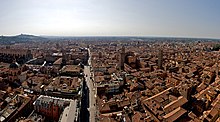
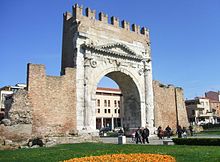
Emilia-Romagna is divided into nine provinces. Apart from the creation of the Metropolitan City of Bologna, plans to reduce the number of provinces from nine to four have been dropped.
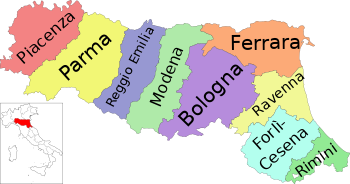
| Province | Area (km2) | Population | Density (inhabitants/km2) | Region |
|---|---|---|---|---|
| Metropolitan City of Bologna | 3,702 | 1,011,291 | 262.9 | Emilia - Romagna
|
| Province of Ferrara | 2,632 | 357,471 | 135.8 | Emilia
|
| Province of Forlì-Cesena | 2,377 | 387,200 | 162.9 | Romagna |
| Province of Modena | 2,689 | 686,104 | 255.1 | Emilia
|
| Province of Parma | 3,449 | 431,419 | 125.1 | Emilia
|
| Province of Piacenza | 2,589 | 284,885 | 110.0 | Emilia
|
| Province of Ravenna | 1,858 | 383,945 | 206.6 | Romagna |
| Province of Reggio Emilia | 2,293 | 517,374 | 225.6 | Emilia
|
| Province of Rimini | 863 | 325,219 | 377.0 | Romagna |
Demographics
| Year | Pop. | ±% |
|---|---|---|
| 1861 | 2,083,000 | — |
| 1871 | 2,228,000 | +7.0% |
| 1881 | 2,289,000 | +2.7% |
| 1901 | 2,547,000 | +11.3% |
| 1911 | 2,813,000 | +10.4% |
| 1921 | 3,077,000 | +9.4% |
| 1931 | 3,267,000 | +6.2% |
| 1936 | 3,339,000 | +2.2% |
| 1951 | 3,578,018 | +7.2% |
| 1961 | 3,692,787 | +3.2% |
| 1971 | 3,866,218 | +4.7% |
| 1981 | 3,977,104 | +2.9% |
| 1991 | 3,928,841 | −1.2% |
| 2001 | 4,003,196 | +1.9% |
| 2011 | 4,344,755 | +8.5% |
| 2021 | 4,425,366 | +1.9% |
| Source: ISTAT | ||
Cities, towns and metropolitan areas
The region has nine cities with populations exceeding one hundred thousand: Bologna, Parma, Modena, Reggio Emilia, Ravenna, Rimini, Ferrara, Forlì and Piacenza. These cities rank among the 50 most populous in Italy. The regional capital, Bologna, has about 400,000 inhabitants and lies at the heart of a metropolitan area of about one million residents.
| Rank | Province | Pop. | Rank | Province | Pop. | ||||
|---|---|---|---|---|---|---|---|---|---|
 Bologna  Parma |
1 | Bologna | Bologna | 390,636 | 11 | Carpi | Modena | 71,836 | Reggio nell'Emilia
|
| 2 | Parma | Parma | 196,518 | 12 | Imola | Bologna | 69,798 | ||
| 3 | Modena | Modena | 186,307 | 13 | Faenza | Ravenna | 58,755 | ||
| 4 | Reggio nell'Emilia |
Reggio nell'Emilia |
171,997 | 14 | Sassuolo | Modena | 40,918 | ||
| 5 | Ravenna | Ravenna | 157,663 | 15 | Casalecchio di Reno | Bologna | 36,512 | ||
| 6 | Rimini | Rimini | 150,576 | 16 | Cento | Ferrara | 35,474 | ||
| 7 | Ferrara | Ferrara | 132,052 | 17 | Riccione | Rimini | 35,181 | ||
| 8 | Forlì | Forlì |
117,798 | 18 | Formigine | Modena | 34,559 | ||
| 9 | Piacenza | Piacenza | 103,942 | 19 | Castelfranco Emilia | Modena | 33,059 | ||
| 10 | Cesena | Forlì |
97,210 | 20 | San Lazzaro di Savena | Bologna | 32,518 | ||
Immigration and ethnicity
| The largest resident foreign-born groups on 31 December 2019[25] | |
|---|---|
| Nationality | Population |
| 93,428 | |
| 60,680 | |
| 57,148 | |
| 31,895 | |
| 28,931 | |
| 26,363 | |
| 22,752 | |
| 18,319 | |
| 17,583 | |
| 15,632 | |
Between 1876 and 1976, about 1.2 million people emigrated from Emilia-Romagna to other countries. As of 2008[update], there were 119,369 people from this region living outside Italy, particularly in
Language
Apart from standard
Economy

Emilia-Romagna today is considered one of the richest European regions and the third wealthiest Italian region by gross domestic product (GDP) per capita.[8] These results have been achieved by developing a very well balanced economy that comprises Italy's biggest agricultural sector as well as a long-standing tradition in automobile, motor and mechanics manufacturing and a strong banking and insurance industry.

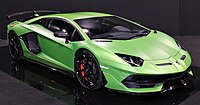

Agriculture
In spite of the depth and variety of industrial activities in the region, agriculture has not been eclipsed. Emilia-Romagna is among the leading regions in the country, with farming contributing 5.8% of the gross regional product. The agricultural sector has aimed for increased competitiveness by means of structural reorganisation and high-quality products, and this has led to the success of marketed brands. Cereals, potatoes, maize, tomatoes and onions are the most important products, along with fruit and grapes for the production of wine (of which the best known are Emilia's Lambrusco, Bologna's Pignoletto, Romagna's Sangiovese and white Albana). Alongside cereals, which for centuries remained the first local product, the cultivation of fruit trees has developed (especially peaches, but also apricots, plums, apples and pears).
Industry
The regional economy is more geared to export markets than other regions in the country: the main exports are from mechanical engineering (53%), the extraction of non-metallic minerals (13%) and the clothing industry (10%).[27] Industry in the region presents a varied and complex picture and is located along the Via Emilia.
The food industry (e.g.
Automotive industry produces sports cars (
Machine building is well-developed and represented with fork-lifts (
There is a chemical industrial park in Ferrara, where different companies manufacturing polyethylene, polypropylene, synthetic rubber and nitrogenous fertilizers. Other industrial park is Mirandola Biomedical District. In Parma there is pharmaceutical manufacturing from Chiesi Farmaceutici.
Sport and fitness articles is manufacturing by Technogym in Cesena.
The ceramic sector is concentrated in Faenza and Sassuolo.
Footwear industry is well developed and located in 2 industrial districts San Mauro Pascoli and between Fusignano and Bagnacavallo.
Tourism
Tourism is increasingly important, especially along the Adriatic coastline and the cities of art. The most popular location for seaside tourism is Rimini. Emilia-Romagna has many small and picturesque villages, 16 of them have been selected by I Borghi più belli d'Italia (English: The most beautiful Villages of Italy),[29] a non-profit private association of small Italian towns of strong historical and artistic interest,[30] that was founded on the initiative of the Tourism Council of the National Association of Italian Municipalities.[31]
Transport
The region of Emilia-Romagna has a very good system of transport, with 574 km of motorways, 1,053 km of railways and airports in Bologna, Forlì, Parma and Rimini. The main motorway crosses the region from north-west (Piacenza) to the south-east (Adriatic coast), connecting the main cities of Parma, Reggio Emilia, Modena, Bologna, and from here further to Ravenna, Rimini and the Adriatic coast.[27]
Unemployment rate
The unemployment rate stood at 5.1% in 2022 and was lower than the national average of 8.1%.[32]
| Year | 2006 | 2007 | 2008 | 2009 | 2010 | 2011 | 2012 | 2013 | 2014 | 2015 | 2016 | 2017 | 2018 | 2019 | 2020 | 2021 | 2022 |
|---|---|---|---|---|---|---|---|---|---|---|---|---|---|---|---|---|---|
| unemployment rate (in %) |
3.4% | 2.8% | 3.2% | 4.6% | 5.6% | 5.2% | 7.0% | 8.4% | 8.3% | 7.7% | 6.9% | 6.5% | 5.9% | 5.5% | 5.7% | 5.6%[33] | 5.1%[34] |
Culture
Cinema

Emilia-Romagna has given birth to a number of important filmmakers and actors and was the main setting for numerous important movies.
Cuisine and gastronomy

Emilia-Romagna is considered one of the richest regions of Italy with regard to its gastronomic and wine-making tradition. The region is known for its egg and filled pasta made with soft wheat flour.

Although the Adriatic coast is a major fishing area which produces eels and clams, the region produces more meat products, especially pork-based, including Parma's .
Music
Emilia-Romagna gave birth to one of the most important composers in the history of music, Giuseppe Verdi, as well as Arturo Toscanini, one of the most acclaimed conductors of the 20th century, and the operatic tenor Luciano Pavarotti.
The region is well known in Italy for its
Sport
Motorsports
Aside from Dovizioso and Capirossi, high-profile racers such as Marco Melandri and Marco Simoncelli have also come out of Emilia-Romagna. Simoncelli died in an accident when he was run over on track in the 2011 Malaysian Grand Prix at the age of 24, and was honoured by having the Misano World Circuit named after him.
Emilia-Romagna have two major international race circuits;
Football
Several clubs from Emilia-Romagna compete at a high level on the national stage.
The
The region has hosted 42 Italy national football team home matches. With 11 professional clubs in 2022/2023 season, the region is only bettered in terms of number of professional clubs by Lombardy. It also has 747 amateur clubs, 1,522 football pitches and 75,328 registered players.[37]
Included in the table below are all sides in the top three tiers of Italian football (Serie A, Serie B and Serie C), as well as any sides that have won major honours.
| Club | Town | Current division | Serie A seasons | Major trophies |
|---|---|---|---|---|
Bologna |
Bologna | Serie A | 77 | 9 |
Cesena |
Cesena | Serie C | 13 | 0 |
Fiorenzuola |
Fiorenzuola d'Arda | Serie C | 0 | 0 |
Modena |
Modena | Serie B | 13 | 0 |
| Parma | Parma | Serie B | 27 | 8 |
Reggiana |
Reggio Emilia | Serie B | 3 | 0 |
Rimini |
Rimini | Serie C | 0 | 0 |
Sassuolo |
Sassuolo | Serie A | 11 | 0 |
S.P.A.L. |
Ferrara | Serie C | 19 | 0 |
Other sports
Another popular sport in this region is
The region has a very strong tradition in
| Club | Town | Current division |
|---|---|---|
| Zebre | Parma | URC |
| Colorno | Colorno | Top10 |
| Lyons | Piacenza | Top10 |
| Valorugby Emilia | Reggio Emilia | Top10 |
| Noceto | Noceto | Serie A |
| Parma | Parma | Serie A |
See also
- Emilian-Romagnol language
- List of European regions by GDP
- Emilia-Romagna luthiers
References
- ^ "Population on 1 January by age, sex and NUTS 2 region", www.ec.europa.eu
- ^ Commission Regulation (EU) 2016/2066 of 21 November 2016 amending the annexes to Regulation (EC) No 1059/2003 of the European Parliament and of the Council on the establishment of a common classification of territorial units for statistics (NUTS)
- ^ "Sub-national HDI - Area Database - Global Data Lab". hdi.globaldatalab.org. Retrieved 5 March 2023.
- ^ "Emilia-Romagna". The American Heritage Dictionary of the English Language (5th ed.). HarperCollins. Retrieved 6 May 2019.
- ^ "Emilia-Romagna". Collins English Dictionary. HarperCollins. Retrieved 6 May 2019.
- ^ "Emilia-Romagna". Lexico UK English Dictionary. Oxford University Press. Archived from the original on 27 May 2022.
- ^ "Emilia-Romagna". Merriam-Webster.com Dictionary. Retrieved 6 May 2019.
- ^ a b Regional GDP per inhabitant in the EU27: GDP per inhabitant in 2005 ranged from 24% of the EU27 average in Nord-Est Romania to 303% in Inner London. European Commission, Eurostat. 12 February 2008.
- ^ "Qualita' della vita: il dossier". Il Sole 24 ORE. Retrieved 28 November 2013.
- ^ "Università di Bologna (oldest university in the world)". Virtual Globetrotting. 21 October 2006. Retrieved 28 November 2013.
- ^ "UNESCO SITES in Emilia Romagna". UNESCO SITES in Emilia Romagna. 16 February 2017. Retrieved 13 April 2018.
- ^ Planet, Lonely. "10 best places to visit in Europe in 2019". Lonely Planet.
- ^ "Cittadini Stranieri in Italia - 2021". Tuttitalia.it (in Italian). Retrieved 19 December 2022.
- Ab Urbe ConditaXXXIX 1; Corpus Inscriptionum Latinarum 617
- ^ "Musei Civici Reggio Emilia » Napoleone e la Repubblica Reggiana". musei.re.it. Retrieved 9 May 2022.
- ^ "Article about the legislation". Archived from the original on 22 July 2011.
- ^ (in Italian) Article Archived 19 April 2016 at the Wayback Machine on "il Resto del Carlino"
- ^ Colleen Barry (30 May 2012). "Dailystar, 17 dead and 200 injured in latest killer quake in northern Italy". Dailystar.com.lb. Retrieved 28 November 2013.
- ^ European Commission (2002). "Communication from the Commission to the Council, the European Parliament, the European Economic and Social Committee and the Committee of the Regions, Towards a Thematic Strategy for Soil Protection. Thematic strategy for soil protection COM(2002)179". European Commission, Brussels.
- .
- ^ Eurostat- Retrieved 4 July 2018
- ^ "Giunta – E-R Il Portale della Regione Emilia-Romagna". Regione.emilia-romagna.it. Retrieved 30 August 2015.
- ^ "Owen Hatherley's Eurovisionaries: Bologna". Architects' Journal. 4 September 2015.
- ^ a b "Emilia-Romagna (Italy). Resident population on 1st January 2019 by territory". dati.istat.it. Istat. Retrieved 7 April 2020.
- National Institute of Statistics. Retrieved 19 June 2018.
- ^ "Museo Nazionale Emigrazione Italiana". Museonazionaleemigrazione.it. Archived from the original on 22 July 2011. Retrieved 28 November 2013.
- ^ a b c "Eurostat". Circa.europa.eu. Archived from the original on 23 February 2009. Retrieved 13 March 2009.
- ISBN 978-1-4020-7555-1. Retrieved 13 April 2012.
- ^ "Emilia Romagna" (in Italian). 10 January 2017. Retrieved 31 July 2023.
- ^ "Borghi più belli d'Italia. Le 14 novità 2023, dal Trentino alla Calabria" (in Italian). 16 January 2023. Retrieved 28 July 2023.
- ^ "I Borghi più belli d'Italia, la guida online ai piccoli centri dell'Italia nascosta" (in Italian). Retrieved 3 May 2018.
- ^ "Lavoro: Istat, nel 2022 tasso disoccupazione giù all'8,1%" (in Italian). Ansa. 15 March 2023.
- ^ "Mercato del lavoro nel secondo trimestre 2020". statistica.regione.emilia-romagna.it (in Italian). Retrieved 14 September 2020.
- ^ "Tasso di disoccupazione per regione" (in Italian). Istat.
- ^ Piras, 187.
- ^ Morlidge, Matt (25 August 2020). "Nurburgring, Portugal and Imola races added to F1 2020 calendar". Sky Sports. Retrieved 28 August 2020.
- ^ "FIGC" (PDF). Archived (PDF) from the original on 19 April 2014. Retrieved 18 April 2014.
- ^ "Zebre rugby: Tutte le notizie sulla storica squadra di Parma". Archived from the original on 23 October 2016. Retrieved 25 October 2014.
Further reading
- Alfani, Guido. "The famine of the 1590s in Northern Italy. An analysis of the greatest "system shock" of sixteenth century." Histoire & mesure 26.XXVI-1 (2011): 17-50 online.
- Bayer, Andrea. North of the Apennines: sixteenth-century Italian painting in Lombardy and Emilia-Romagna (Metropolitan Museum of Art, 2003).
- Bianchi, Patrizio, and Maria Grazia Giordani. "Innovation policy at the local and national levels: The case of Emilia‐Romagna." European Planning Studies 1.1 (1993): 25–41.
- Cooke, Philip. "Building a twenty‐first century regional economy in Emilia‐Romagna." European Planning Studies 4.1 (1996): 53–62.
- Passarelli, Gianluca, and Dario Tuorto. "The Lega Nord goes south: The electoral advance in Emilia-Romagna: A new territorial model?." Political Geography 31.7 (2012): 419-428 online[dead link].
- Rossi, Leonardo, Britta Holtschoppen, and Christoph Butenweg. "Official data on the economic consequences of the 2012 Emilia-Romagna earthquake: a first analysis of database SFINGE." Bulletin of Earthquake Engineering 17.9 (2019): 4855–4884.
Guide books
- Facaros, Dana, and Michael Pauls. Northern Italy: Emilia-Romagna: including Bologna, Ferrara, Modena, Parma, Ravenna and the Republic of San Marino (2018) – excerpt
- Macadam, Alta. Blue Guide Emilia Romagna (2017) – excerpt

